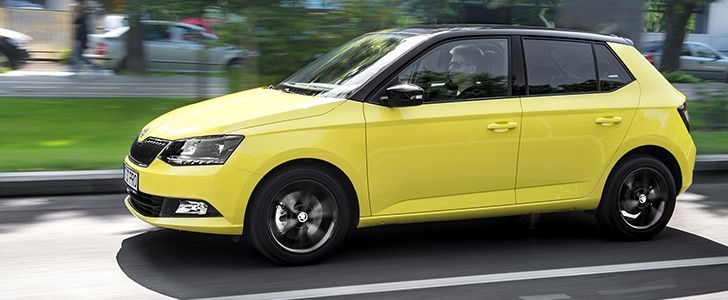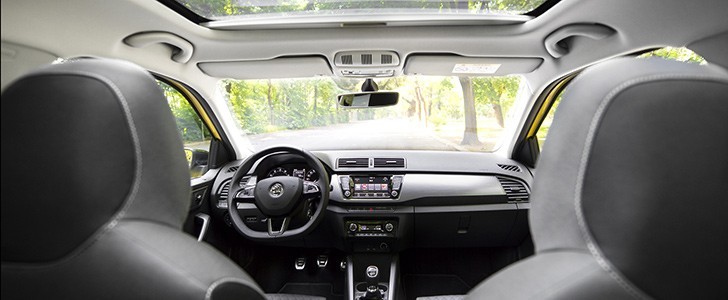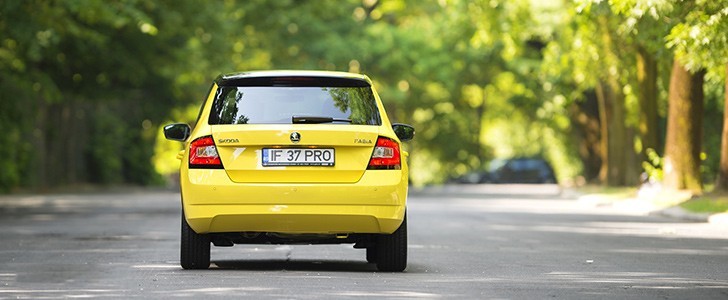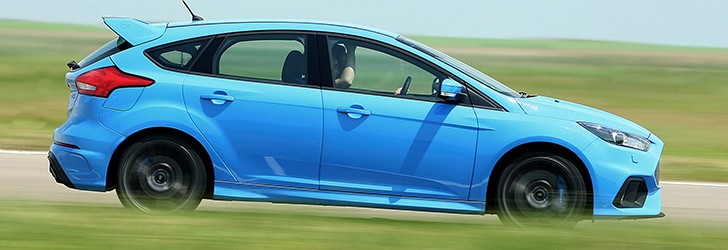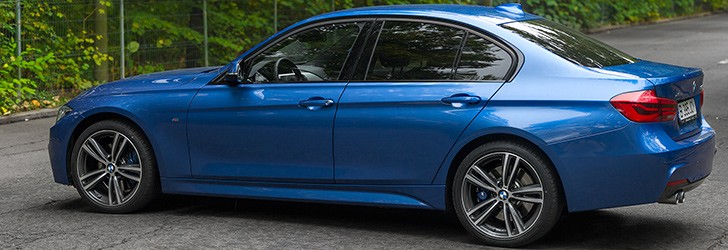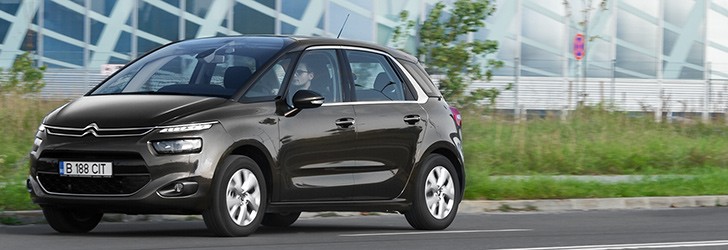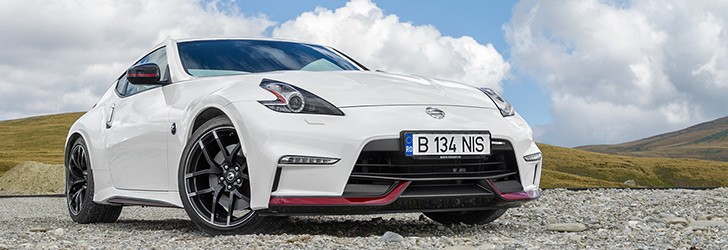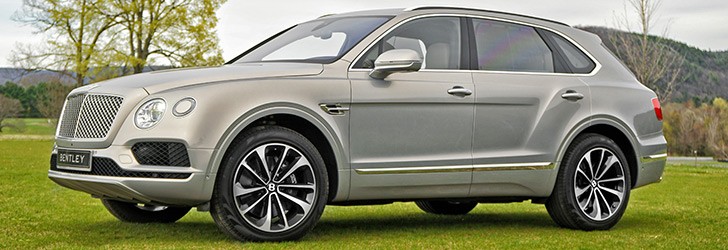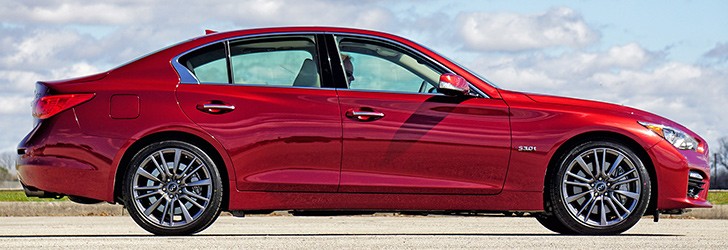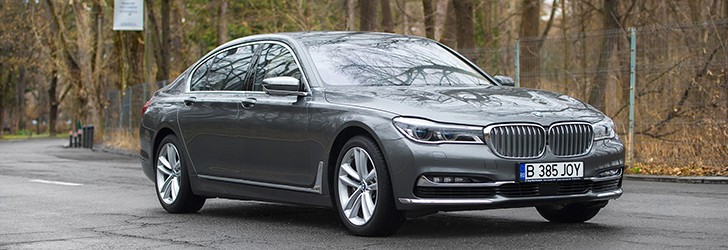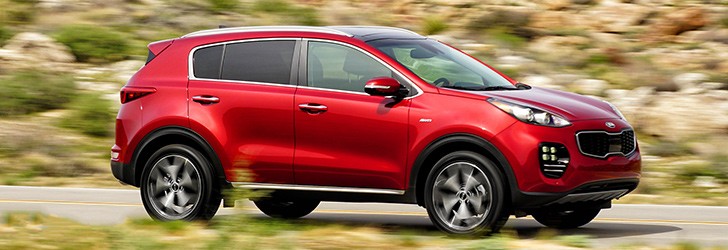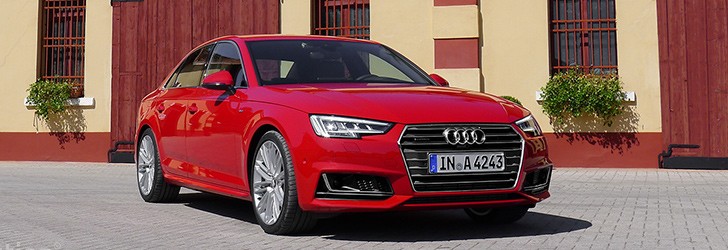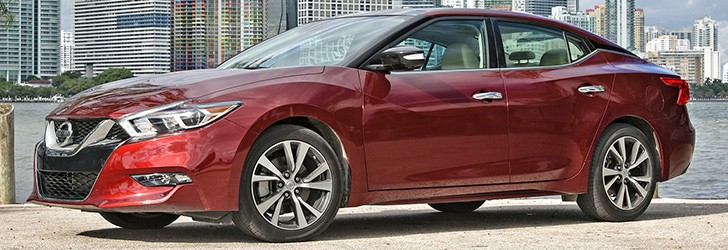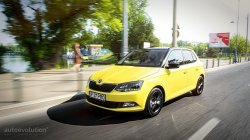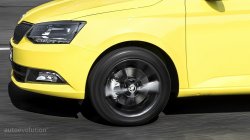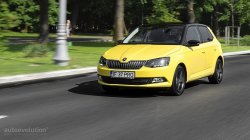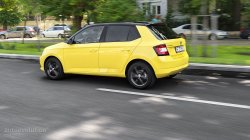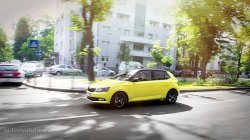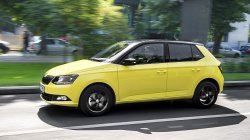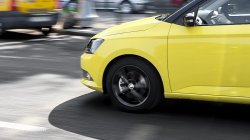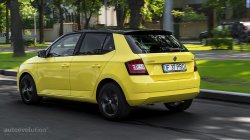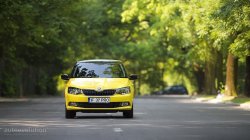2015 Skoda Fabia Review
OUR TEST CAR: 2015 Skoda Fabia Style 1.2 TSI 110 HP 6-Speed Manual
Superminis like the VW Polo and Ford Fiesta have been best-sellers in Europe for decades, and with good reason. They are cheap to buy, efficient to run and practical. The first two generations of the Skoda Fabia had those attributes as well. But the all-new 2015 Fabia we're reviewing proved to us that the Czech company has moved from making budget cars to competing with the segment leaders in terms of emotional impact.
Let's start from the beginning. The Fabia entered production in 1999, which means it's one of the youngest models Skoda has, yet also one of the most successful. It's always been based on the contemporary Volkswagen Polo platform, and its affordable prices meant plenty of people bought one. But due to its uninspiring design and outdated features, the Mk2 Fabia, launched in 2007, saw declining demand in the last two years of its life. Considering 3.5 million people have bought a Fabia, they needed a solution for this problem.
At the 2014 Paris Motor Show, the hotly anticipated replacement was unveiled, the all-new Fabia we are testing today. Underneath the body, this 5-door is a complex mixture of brand new and revised components. Skoda describes it as having 10% of the parts from the old Fabia, 40% improved parts from VW's supermini platform (Polo) and 50% "MQB modules".
On paper, that makes the Fabia 3 sound like a facelift, but that's totally unfair. Skoda used existing parts from the Volkswagen Group because they work - the 1.2 TSI turbo engines have proven themselves on best-selling Golf models while the infotainment system used is one of the best in any non-premium car.
Let's begin our examination of the 2015 Fabia with the exterior. Look beyond the yellow paint and tell us what you see. Yes, the Fabia has become wider by 90mm (3.5 inches) and a little bit less tall. This instantly nullifies the somewhat unstable and tall look of the older model.
You can make up your own mind if the car is a looker or not by browsing through our photo gallery. In black or silver, the design is undeniably understated, especially compared to the Peugeot 208 and Renault Clio. However, this particular Skoda Fabia wasn't black or silver; it was as yellow as a lemon and with black accents seemed like it wanted to mimic Bumblebee from the Transformers series.
Jozef Kaban, Skoda's chief designer, was tasked with making a small car that looked a lot like the Fabia vRS racing car. We believe he has been successful in the flat shoulders of the Fabia that echo those of the WRC machine. Secretly though, we also believe he was told to make the Fabia that still appeals to elderly customers, as they are very important for the Skoda brand. Remember, Volkswagen Group is Europe's biggest automaker by volume, so holding onto the existing clientele is better than rocking the boat with revolutionary features.
From the front, the Fabia looks like a combination between the Polo 6R and the Octavia. Its headlights are square and connect directly to a black grille with chrome inserts. This cosmetic artifice has been used to make the front fascia appear wider. Below that, we see another grille and quite large fog lights, both design features that carry over from the previous Fabia model.
In profile, the 2015 Fabia is clean and simple. There aren't any hidden door handles like on the Clio or large chrome trim badges such as the ones on the Peugeot 208. It also doesn't try to appear more sporty by lowering the roofline towards the boot like the Ford Fiesta. The upside to this straight design is that you get excellent side visibility and good headroom. The rear is perhaps the least interesting bit to look at because it's completely flat and lacks the LED embellishments we've come to expect from cars these days.
Any true Skoda thinks of functionality and practicality first, so we need to open the boot and look at the car from another angle. With 330 liters (72 UK gallons) of space, the new Fabia is by far the best car in its class when it comes to making trips to the shops. In fact, it can be compared to some larger cars, such as the Ford Focus (363 liters).
We think boot space and the efficiency of the diesel engines are the two main reasons people will buy the new Skoda Fabia. We subjected the car to the ultimate test: doing the weekly shopping and visiting fashion outlets at the same time. Without even needing to fold the seats, we were able to fit 40 liters of bottled water, two large bags of groceries and several eclectic nicknacks, which this editor still can't comprehend. (why buy three different types of mascara?)
But it's not a man's place to judge the utility of makeup kits, as his role require him behind the wheel, gingerly driving back home so as not to spill slushy drinks or break eggs. The 2015 Fabia helps with that as well, as it comes with plenty of safety nets and specially designed shelves to store bottles. The cup holders are also note-worthy, as they have a rubberized bottom which means you can unscrew bottle tops with just one hand. Behold the wisdom of the Czechs!
People often joke that small cars are like refrigerators on wheels, and by that they mean that they aren't fun. But the Fabia is like a refrigerator in other ways. For example, there are shelves in the back that keep smaller objects safe, like the milk bottles you would place on your fridge door. 2015 Fabia models don't have a false floor because engineers thought it would eat into the available space. But the top parcel shelf can be removed and installed in the middle of the trunk, essentially giving you two levels to put stuff on. Again, this feature reminded us of refrigerators and the way in which their shelves can be adjusted.
The doors are almost square and open widely, so getting in and out is easy. And when you wake up on that cold December morning to discover the windscreens are covered in ice, there's a cool little scraper tool stowed away in the gas filler flap. There are more practical features in the cabin as well, such as a storage bin for the door pocket and nets on the side of your seat. The only quibbles we had with the Fabia's practical side were the load lip and the fact that the seats don't fold completely flat.
The Fabia feels nearly identical to the VW Polo from behind the wheel, right down to the places where the elbows touch the door and center armrest, or the placement of the infotainment system. Skoda may be right that the Fabia 3 is wider than its predecessor, but the front track and wheelbase are identical to those of the German sister car.
The similarities continue with the placement and design of the steering wheel, the 6.5-inch infotainment system, climate control system, gear shifter and handbrake. Of course, all these pieces are dressed in Skoda-specific trim. Yes, the car compromises on originality, but it's a good think that you can buy Golf-like interior components a with rewarding mechanical feel to them in a cheaper car.
Skoda has tried to cut costs wherever possible and keep the money invested in technologies that matter. That's why the plastic used for the dash is hard and so is the one for the doors. The glovebox, which you use very often, is damped, but the grab handles on the roof are not because it's cheaper that way, and the mirrors in the visors don't have lights. Yet from a distance, the Fabia's cabin actually looked more premium than that of the Polo we tested last year, partly due to the brushed metal trim piece going across the dash, but also because of the optional features we had on our tester. Only close contact with the materials revealed half of quality is a visual illusion.
The most interesting was a full panoramic roof that extended almost from the windscreen to the boot. Care to guess how much it costs? €2000? How about only €512, which is so cheap we think it's a shame not to order it. The sports seats with integrated headrests were also affordable (€154), as was the €186 flat-bottomed steering wheel.
The editorial team was divided by both these features, but we eventually came to the conclusion that they're excellent for young drivers who have never owned a sportscar. In traffic, the thick grips of this specially designed wheel feel awkward, especially as you quickly realize it's not a chuckable Miata, just a small family car. As for the seats, they are relatively comfortable and remind you of the typical Audi S line design, but the side bolsters are overkill in a car that delivers no more than 110 horsepower.
Underneath all the fabric and plastic, the 3rd generation Fabia is a mix of brand new technologies and re-engineered older ones. The Czech company also claims that up to 65 kilos (143 lbs) of weight have been shed, but this is not a featherweight, just a small car that falls in line with its class rivals. With a diesel engine and DSG gearbox, the Fabia can come close to 1.2 tons. Being wider yet slightly lighter than before also brings a few dynamic advantages, but we'll tell you more about that later.
All the engines offered on the Fabia are brand new. Base models come with the pint-sized 1.0 MPI, which is a naturally aspirated 3-cylinder engine that replaces the old 1.2. The lower output version delivers 60 hp and 95 Nm of torque (70 lb-ft), followed by a 75 hp model with the same amount of torque. Because they take about 15 seconds to reach 100 km/h (62 mph) and have no real fuel economy benefits, we think it's unquestionably worth upgrading to a turbo model.
Two slightly different 1.2 TSI units can be found under the bonnet of the 2015 Fabia. The base one makes 90 hp, 160 Nm (118 lb-ft) of torque and is available only with a 5-speed manual. A high-output version with four valves per cylinder offers 110 hp, 175 Nm (129 lb-ft) and gives you access to either a 6-speed manual or the 7-speed DSG. This Czech-built twin-clutch auto (DQ200) has been the subject of a massive global recall, but it's covered by the warranty and has probably had all its Mechatronic gremlins worked out.
Skoda has been using the 1.2 TSI for so long that we can't even call it downsizing any more. However, these are not the same as the older mills. They have different turbocharger placement, brake energy recovery and standard stop-start. Combined, these features help reduce fuel consumption in the city by about 0.5 l/100km.
Why is Skoda sticking with a 1.2-liter turbo 4-cylinder engine when Ford, Opel, Peugeot and Renault all use 3-cylinder ones with 1-liter displacement (or less)? Well, you don't have to change gears as often, anticipate traffic or thrash the engine to get the maximum performance. Keen drivers may want to know that the ECU is set up for comfort and low consumption, not outright performance. Below 2,000 rpm, our test car didn't feel like it had the claimed 110 hp. Despite less torque, the naturally aspirated Mazda2 with 115 hp is 0.7 seconds faster to 100 km/h.
But perhaps it's unreasonable to expect best-in-class performance from the Skoda Fabia, so let's look at the diesel range instead. Before, the range was divided into 1.2 TDI base mills and 1.6 TDI high-spec ones. Now, the Fabia only has 1.4 TDI units, brand new units with three cylinders and available in three power outputs: 75, 90 and 105 hp. In late 2015, a 1.4-liter diesel Greenline model will be launched, capable of emissions as low as 82 g/100km. They match the relaxed attitude of the car well and offer fuel consumption that's lowered by about one third compared to the 1.2 TSI petrols.
Speaking of which, we have to tell that, like most downsized engines, matching the official fuel consumption numbers is nearly impossible. For instance the formal highway consumption number is 4 l/100km (71 mpg UK), but no matter what we tried, the small screen between the speedo and rev counter wouldn't go below 4.7 and at the end of a long journey we were content with 5.5 liters per 100 kilometers (60 mpg UK). Around town, cruising through regular traffic conditions, our results showed 8.1 l/100km (51 mpg UK), about 30% more than officially claimed. It is worth considering, however, that this brand new Skoda was nowhere near being fully run in and after about 5,000 km (3100 miles) of its life, these crucial numbers will improve slightly.
Fabia buyers that expect to do longer motorway journeys are advised to order the diesel engines, which also have lower servicing costs than their predecessors. But for those who use it as a second car, for shopping or weekend getaways, the 1.2 TSI should be the prime pick.
The driving experience is dominated by a feeling of improved refinement. Skoda has stiffened the chassis, so there's not a hint of flexing over bumps, and more soundproofing has been used. Even at highway speeds, you can hold a conversation or enjoy the radio, unlike in the previous Fabia.
With a much wider body, the Fabia corners better, but there is no modularity in the way it handles. It just grips and takes corners, without letting you enjoy any heart-racing experiences. The slightly notchy gearbox has a long throw, but the clutch is nice and progressive. The Fabia is very predictable, giving you ample warning before it lets go. Overall, this predictable setup will appeal to the vast majority of drivers, while those who are keener can only look forward to the turbo punch at high revs.
The suspension system is on the firm side, not helped by the 16-inch wheels. Over larger bumps, it feels as if the Fabia is rushing to "put its foot down", although at higher speeds the characteristic is less noticeable. Like most small cars, beam axle rear suspension is an Achilles heel. This unsophisticated setup has been given a bit more structural rigidity and copes surprisingly well with constantly uneven surfaces (cobbled roads).
From the very beginning of the new Fabia's development, safety was given top priority. The result is that after Euro NCAP had tested the car, they said it was the class leader, naturally accompanying this with a 5-star rating. An 81% safety score for child occupant protection was deemed particularly high, and the safety body also praised the active safety systems. Available as an option on the new hatch, the Driver Activity Assistant is a fatigue detection system that brings tech made famous by Mercedes-Benz about a decade ago. Other safety systems include a speed limiter, hill-hold control, and an electronic tire pressure monitor.
Prices for the new Fabia start at €11,970 in Germany, which isn't a lot when you consider the 5-door body is standard while some rival companies as extra. But the best value is offered in the higher Ambition and Style trim levels, which have alloy wheels, better headlights, and even a Climatronic system.
Our Fabia Style 1.2 TSI 110 HP with a 6-speed manual sticker for €16,344, which is excellent considering how eye catching this black-on-yellow combination was. If this isn't for you, there are 12 other exterior colors to choose from, plus another 4 for the wheels, mirrors and roof. Skoda tells us it can be configured in 100 different ways, a Fiat-500-like level of chromatic versatility.
Why shouldn't you buy the 2015 Skoda Fabia? Because it's not as fun to drive as the Ford Fiesta and Mazda2. Why should you buy the 2015 Skoda Fabia? Because it offers great value and the biggest boot in this class. It's also superior in terms of comfort, economy and quality to its predecessor, so a trade-in is a good idea.
The Fabia has always been a rational decision on wheels, not an emotional one, so nobody can say if it's the right car for you. However, we see it as most of the Volkswagen technologies for around 90% of the money. It's hard to argue with the numbers.
At the 2014 Paris Motor Show, the hotly anticipated replacement was unveiled, the all-new Fabia we are testing today. Underneath the body, this 5-door is a complex mixture of brand new and revised components. Skoda describes it as having 10% of the parts from the old Fabia, 40% improved parts from VW's supermini platform (Polo) and 50% "MQB modules".
On paper, that makes the Fabia 3 sound like a facelift, but that's totally unfair. Skoda used existing parts from the Volkswagen Group because they work - the 1.2 TSI turbo engines have proven themselves on best-selling Golf models while the infotainment system used is one of the best in any non-premium car.
Let's begin our examination of the 2015 Fabia with the exterior. Look beyond the yellow paint and tell us what you see. Yes, the Fabia has become wider by 90mm (3.5 inches) and a little bit less tall. This instantly nullifies the somewhat unstable and tall look of the older model.
You can make up your own mind if the car is a looker or not by browsing through our photo gallery. In black or silver, the design is undeniably understated, especially compared to the Peugeot 208 and Renault Clio. However, this particular Skoda Fabia wasn't black or silver; it was as yellow as a lemon and with black accents seemed like it wanted to mimic Bumblebee from the Transformers series.
Jozef Kaban, Skoda's chief designer, was tasked with making a small car that looked a lot like the Fabia vRS racing car. We believe he has been successful in the flat shoulders of the Fabia that echo those of the WRC machine. Secretly though, we also believe he was told to make the Fabia that still appeals to elderly customers, as they are very important for the Skoda brand. Remember, Volkswagen Group is Europe's biggest automaker by volume, so holding onto the existing clientele is better than rocking the boat with revolutionary features.
From the front, the Fabia looks like a combination between the Polo 6R and the Octavia. Its headlights are square and connect directly to a black grille with chrome inserts. This cosmetic artifice has been used to make the front fascia appear wider. Below that, we see another grille and quite large fog lights, both design features that carry over from the previous Fabia model.
The 2015 Fabia has curb appeal without throwing away practicality.
In profile, the 2015 Fabia is clean and simple. There aren't any hidden door handles like on the Clio or large chrome trim badges such as the ones on the Peugeot 208. It also doesn't try to appear more sporty by lowering the roofline towards the boot like the Ford Fiesta. The upside to this straight design is that you get excellent side visibility and good headroom. The rear is perhaps the least interesting bit to look at because it's completely flat and lacks the LED embellishments we've come to expect from cars these days.
Any true Skoda thinks of functionality and practicality first, so we need to open the boot and look at the car from another angle. With 330 liters (72 UK gallons) of space, the new Fabia is by far the best car in its class when it comes to making trips to the shops. In fact, it can be compared to some larger cars, such as the Ford Focus (363 liters).
We think boot space and the efficiency of the diesel engines are the two main reasons people will buy the new Skoda Fabia. We subjected the car to the ultimate test: doing the weekly shopping and visiting fashion outlets at the same time. Without even needing to fold the seats, we were able to fit 40 liters of bottled water, two large bags of groceries and several eclectic nicknacks, which this editor still can't comprehend. (why buy three different types of mascara?)
But it's not a man's place to judge the utility of makeup kits, as his role require him behind the wheel, gingerly driving back home so as not to spill slushy drinks or break eggs. The 2015 Fabia helps with that as well, as it comes with plenty of safety nets and specially designed shelves to store bottles. The cup holders are also note-worthy, as they have a rubberized bottom which means you can unscrew bottle tops with just one hand. Behold the wisdom of the Czechs!
People often joke that small cars are like refrigerators on wheels, and by that they mean that they aren't fun. But the Fabia is like a refrigerator in other ways. For example, there are shelves in the back that keep smaller objects safe, like the milk bottles you would place on your fridge door. 2015 Fabia models don't have a false floor because engineers thought it would eat into the available space. But the top parcel shelf can be removed and installed in the middle of the trunk, essentially giving you two levels to put stuff on. Again, this feature reminded us of refrigerators and the way in which their shelves can be adjusted.
The doors are almost square and open widely, so getting in and out is easy. And when you wake up on that cold December morning to discover the windscreens are covered in ice, there's a cool little scraper tool stowed away in the gas filler flap. There are more practical features in the cabin as well, such as a storage bin for the door pocket and nets on the side of your seat. The only quibbles we had with the Fabia's practical side were the load lip and the fact that the seats don't fold completely flat.
The Fabia feels nearly identical to the VW Polo from behind the wheel, right down to the places where the elbows touch the door and center armrest, or the placement of the infotainment system. Skoda may be right that the Fabia 3 is wider than its predecessor, but the front track and wheelbase are identical to those of the German sister car.
The similarities continue with the placement and design of the steering wheel, the 6.5-inch infotainment system, climate control system, gear shifter and handbrake. Of course, all these pieces are dressed in Skoda-specific trim. Yes, the car compromises on originality, but it's a good think that you can buy Golf-like interior components a with rewarding mechanical feel to them in a cheaper car.
Skoda has tried to cut costs wherever possible and keep the money invested in technologies that matter. That's why the plastic used for the dash is hard and so is the one for the doors. The glovebox, which you use very often, is damped, but the grab handles on the roof are not because it's cheaper that way, and the mirrors in the visors don't have lights. Yet from a distance, the Fabia's cabin actually looked more premium than that of the Polo we tested last year, partly due to the brushed metal trim piece going across the dash, but also because of the optional features we had on our tester. Only close contact with the materials revealed half of quality is a visual illusion.
At 330 liters, the boot is so big it compares to the class above. It's also very clever.
The most interesting was a full panoramic roof that extended almost from the windscreen to the boot. Care to guess how much it costs? €2000? How about only €512, which is so cheap we think it's a shame not to order it. The sports seats with integrated headrests were also affordable (€154), as was the €186 flat-bottomed steering wheel.
The editorial team was divided by both these features, but we eventually came to the conclusion that they're excellent for young drivers who have never owned a sportscar. In traffic, the thick grips of this specially designed wheel feel awkward, especially as you quickly realize it's not a chuckable Miata, just a small family car. As for the seats, they are relatively comfortable and remind you of the typical Audi S line design, but the side bolsters are overkill in a car that delivers no more than 110 horsepower.
Underneath all the fabric and plastic, the 3rd generation Fabia is a mix of brand new technologies and re-engineered older ones. The Czech company also claims that up to 65 kilos (143 lbs) of weight have been shed, but this is not a featherweight, just a small car that falls in line with its class rivals. With a diesel engine and DSG gearbox, the Fabia can come close to 1.2 tons. Being wider yet slightly lighter than before also brings a few dynamic advantages, but we'll tell you more about that later.
All the engines offered on the Fabia are brand new. Base models come with the pint-sized 1.0 MPI, which is a naturally aspirated 3-cylinder engine that replaces the old 1.2. The lower output version delivers 60 hp and 95 Nm of torque (70 lb-ft), followed by a 75 hp model with the same amount of torque. Because they take about 15 seconds to reach 100 km/h (62 mph) and have no real fuel economy benefits, we think it's unquestionably worth upgrading to a turbo model.
Two slightly different 1.2 TSI units can be found under the bonnet of the 2015 Fabia. The base one makes 90 hp, 160 Nm (118 lb-ft) of torque and is available only with a 5-speed manual. A high-output version with four valves per cylinder offers 110 hp, 175 Nm (129 lb-ft) and gives you access to either a 6-speed manual or the 7-speed DSG. This Czech-built twin-clutch auto (DQ200) has been the subject of a massive global recall, but it's covered by the warranty and has probably had all its Mechatronic gremlins worked out.
Skoda has been using the 1.2 TSI for so long that we can't even call it downsizing any more. However, these are not the same as the older mills. They have different turbocharger placement, brake energy recovery and standard stop-start. Combined, these features help reduce fuel consumption in the city by about 0.5 l/100km.
Why is Skoda sticking with a 1.2-liter turbo 4-cylinder engine when Ford, Opel, Peugeot and Renault all use 3-cylinder ones with 1-liter displacement (or less)? Well, you don't have to change gears as often, anticipate traffic or thrash the engine to get the maximum performance. Keen drivers may want to know that the ECU is set up for comfort and low consumption, not outright performance. Below 2,000 rpm, our test car didn't feel like it had the claimed 110 hp. Despite less torque, the naturally aspirated Mazda2 with 115 hp is 0.7 seconds faster to 100 km/h.
But perhaps it's unreasonable to expect best-in-class performance from the Skoda Fabia, so let's look at the diesel range instead. Before, the range was divided into 1.2 TDI base mills and 1.6 TDI high-spec ones. Now, the Fabia only has 1.4 TDI units, brand new units with three cylinders and available in three power outputs: 75, 90 and 105 hp. In late 2015, a 1.4-liter diesel Greenline model will be launched, capable of emissions as low as 82 g/100km. They match the relaxed attitude of the car well and offer fuel consumption that's lowered by about one third compared to the 1.2 TSI petrols.
Speaking of which, we have to tell that, like most downsized engines, matching the official fuel consumption numbers is nearly impossible. For instance the formal highway consumption number is 4 l/100km (71 mpg UK), but no matter what we tried, the small screen between the speedo and rev counter wouldn't go below 4.7 and at the end of a long journey we were content with 5.5 liters per 100 kilometers (60 mpg UK). Around town, cruising through regular traffic conditions, our results showed 8.1 l/100km (51 mpg UK), about 30% more than officially claimed. It is worth considering, however, that this brand new Skoda was nowhere near being fully run in and after about 5,000 km (3100 miles) of its life, these crucial numbers will improve slightly.
Fabia buyers that expect to do longer motorway journeys are advised to order the diesel engines, which also have lower servicing costs than their predecessors. But for those who use it as a second car, for shopping or weekend getaways, the 1.2 TSI should be the prime pick.
The driving experience is dominated by a feeling of improved refinement. Skoda has stiffened the chassis, so there's not a hint of flexing over bumps, and more soundproofing has been used. Even at highway speeds, you can hold a conversation or enjoy the radio, unlike in the previous Fabia.
With a much wider body, the Fabia corners better, but there is no modularity in the way it handles. It just grips and takes corners, without letting you enjoy any heart-racing experiences. The slightly notchy gearbox has a long throw, but the clutch is nice and progressive. The Fabia is very predictable, giving you ample warning before it lets go. Overall, this predictable setup will appeal to the vast majority of drivers, while those who are keener can only look forward to the turbo punch at high revs.
The suspension system is on the firm side, not helped by the 16-inch wheels. Over larger bumps, it feels as if the Fabia is rushing to "put its foot down", although at higher speeds the characteristic is less noticeable. Like most small cars, beam axle rear suspension is an Achilles heel. This unsophisticated setup has been given a bit more structural rigidity and copes surprisingly well with constantly uneven surfaces (cobbled roads).
We did not expect this slightly firmer suspension from the sensible Skoda brand.
From the very beginning of the new Fabia's development, safety was given top priority. The result is that after Euro NCAP had tested the car, they said it was the class leader, naturally accompanying this with a 5-star rating. An 81% safety score for child occupant protection was deemed particularly high, and the safety body also praised the active safety systems. Available as an option on the new hatch, the Driver Activity Assistant is a fatigue detection system that brings tech made famous by Mercedes-Benz about a decade ago. Other safety systems include a speed limiter, hill-hold control, and an electronic tire pressure monitor.
Prices for the new Fabia start at €11,970 in Germany, which isn't a lot when you consider the 5-door body is standard while some rival companies as extra. But the best value is offered in the higher Ambition and Style trim levels, which have alloy wheels, better headlights, and even a Climatronic system.
Our Fabia Style 1.2 TSI 110 HP with a 6-speed manual sticker for €16,344, which is excellent considering how eye catching this black-on-yellow combination was. If this isn't for you, there are 12 other exterior colors to choose from, plus another 4 for the wheels, mirrors and roof. Skoda tells us it can be configured in 100 different ways, a Fiat-500-like level of chromatic versatility.
Why shouldn't you buy the 2015 Skoda Fabia? Because it's not as fun to drive as the Ford Fiesta and Mazda2. Why should you buy the 2015 Skoda Fabia? Because it offers great value and the biggest boot in this class. It's also superior in terms of comfort, economy and quality to its predecessor, so a trade-in is a good idea.
The Fabia has always been a rational decision on wheels, not an emotional one, so nobody can say if it's the right car for you. However, we see it as most of the Volkswagen technologies for around 90% of the money. It's hard to argue with the numbers.
Our latest Testdrives:
Photo gallery (60)
